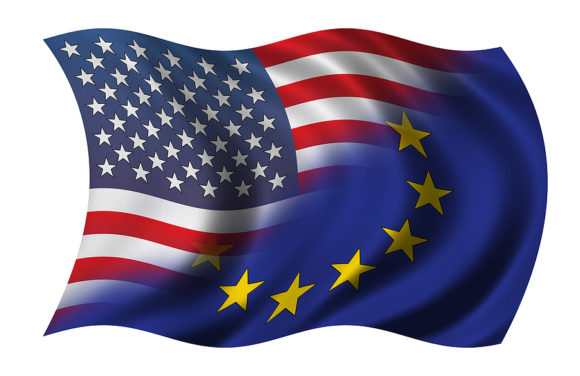Negotiations for a free-trade agreement between the United States and the European Union are set to begin within months, almost two decades after the idea was first floated between the world’s two largest economies.
Average tariffs between the two are already low, so most of the benefit is expected to come from harmonizing regulations, so that a product or service approved in Europe can be readily sold in the United States and vice versa.
The EU exported €260.6 billion [$350.76 billion] of goods to the United States in 2011, with €184.2 billion [$248 billion] going the other way. In services, EU exports were €127.1 billion [$171 billion] and imports €130.5 billion [$175.65 billion].
Lower trade barriers could also hasten direct investment across the Atlantic, which so far amounts to about $1.9 trillion [€1.41159 trillion] by U.S. firms and $1.6 trillion [€1.1887 trillion] from the EU.
Below are some details of the planned “Transatlantic Trade and Investment Partnership” and its ambitions.
POTENTIAL BENEFITS
* A comprehensive deal could increase Europe’s economic output by €86 billion [$115.75 billion] a year, equivalent to a 0.5 percent rise into the EU’s gross domestic product, and the U.S. economy by €65 billion [$87.5 billion] or 0.4 percent by 2027.
* With the United States and the European Union already in regional trade agreements, a trade agreement between the two would effectively extend the reach of the markets for existing agreements like NAFTA and the EU’s South American agreements.
MARKET ACCESS
* To get as close as possible to the removal of all duties on transatlantic trade in agricultural and industrial products, which currently average 5.2 percent for the EU and 3.5 percent for the United States. Removing tariffs, the U.S. Chamber of Commerce estimates, would boost economic growth by $180 billion [€133.7 billion] over five years.
* To open trade in services in new sectors and bring investment rules up to the highest standard negotiated so far in other trade deals.
The large reinsurance market in the EU faces restrictions such as collateral requirements and differing regulations of U.S. states. Reducing barriers to trade could result in gains of €2.3 billion [$3.1 billion] a year for the United States from lower prices for insurance.
* To open public procurement markets at all levels of government. The EU says business dependent on public procurement account for 25 percent of GDP and 31 million jobs.
SHARED STANDARDS
* An ambitious agreement on plant and animal health and food hygiene standards.
EU naming regulations for artisanal products, such as cheese, are more restrictive than in the United States, and European food and drinks producers are keen for American producers to agree to their rules.
Leaders of the Senate Finance Committee want the EU to lower restrictions on genetically modified crops, poultry treated with chlorine washes to kill pathogens and meat from animals fed the growth stimulant ractopamine. But the EU says legislating new rules on genetically modified organisms is not on the table.
* Regulatory compatibility in the chemical, automotive, pharmaceutical and medical appliances sectors, with a “living agreement” that can be progressively strengthened.
Roughly 40 percent of EU cars exported are destined for the U.S. market. Harmonizing rules such as safety standards, certification processes and environmental regulations surrounding components could yield savings of up to €12 billion [$16.15 billion] annually for the EU and €1.6 billion [$2.15 billion] for the United States.
Joint rules on pharmaceutical labeling and recognizing each other’s drug approvals could yield €2.2 billion [$2.96 billion] per year for both the U.S. and EU pharmaceutical sectors.
* To address a few areas of divergence in intellectual property rights, with no plan to harmonize the two systems overall.
* To develop common rules and principles for trade-related issues of global concern, such as customs red-tape, competition policy, state-owned enterprises, rules that favor local firms over importers, raw materials and energy, small and medium-sized enterprises, and transparency.
Sources: Final report of US-EU High Level Working Group on Jobs and Growth, USTR, European Commission, 2009 ECORYS report for Commission, U.S. Chamber of Commerce
(Reporting By Ethan Bilby and Tom Miles; Editing by Peter Graff)
Topics USA Legislation Europe Reinsurance
Was this article valuable?
Here are more articles you may enjoy.



 New York Governor Hochul Vows to Tackle Insurance Affordability, Litigation and Fraud
New York Governor Hochul Vows to Tackle Insurance Affordability, Litigation and Fraud  Experian: AI Agents Could Overtake Human Error as Major Cause of Data Breaches
Experian: AI Agents Could Overtake Human Error as Major Cause of Data Breaches  CEOs on Guard as Trump Rattles Companies With Series of Edicts
CEOs on Guard as Trump Rattles Companies With Series of Edicts  MAPFRE Accuses AAA of Violating Long-Time Exclusive Marketing Agreement
MAPFRE Accuses AAA of Violating Long-Time Exclusive Marketing Agreement 

